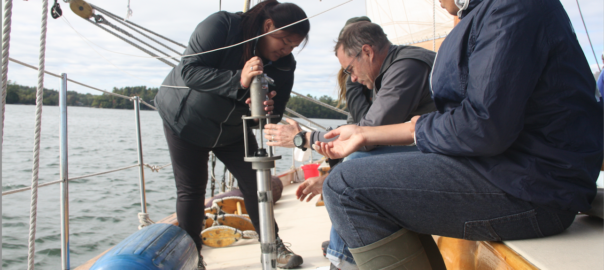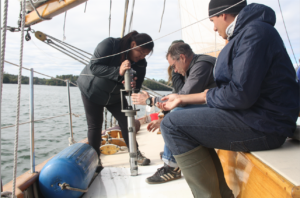Our second home base while on our schooner adventure was Hermit Island. Don’t let the name fool you though, it isn’t actually an island! Getting to Hermit involved some beautiful warm, but slow, sailing. At one point, after seeing a small pod of porpoises, the waters of outer Casco Bay were so calm the captain issued a swim call, which meant it was time to get wet! Many jumped off the Bagheera while some stayed on deck and watched the fun unfold. The waters were slightly cold but that’s expected for a swim in early October.
We arrived via the Bagheera right as the sun was beautifully setting in the distance, and Dr. Erikson shuttled us and our gear to the campsite. Tents and dinner were prepared in the dark with our only light source being our head lamps as the days keep getting shorter and shorter. An early bedtime in preparation for a new day followed soon, but not before a campfire was made to roast marshmallows!
After breakfast the next day we again boarded Bagheera to head to the New Meadows River estuary. This estuary is restricted with little flushing of water, and therefore we expected this might be a place with some stratification caused by density differences of the fresh and salt water. As we took sonde measurements (temperature, salinity, pH etc.) heading up the river from mouth to head of the estuary we observed the highest chlorophyll amounts of the trip so far, up to 18 micrograms/L! This indicates a large nutrient input most likely from the river and runoff which fuels phytoplankton production. Along with the sonde data we also took a core sample from the sediments deep below the water. We watched as our coring device, which looks like a long metal tube with teeth inside, plummeted down to the bottom and slowly got cranked back up with some human horsepower. This core sample was smooth, similar to an ice cream consistency! There were no sand particles present, it had a deep dark mud color and was also pretty smelly due to hydrogen sulfide. This smell indicates this was most likely an anoxic mud layer full of organic matter. As we left the estuary, we had a short lecture on how large fish kills can occur due to anoxic conditions in the estuary. As the stay filled with science and adventure came to an end, we once again enjoyed a shuttle ride to the campsite. These shuttle rides were short, but I particularly enjoyed reading all of the names of the lobster boats as we rode through. The stay on Hermit island was short, but the memories will certainly last much longer!
-Jess Selva ’17



